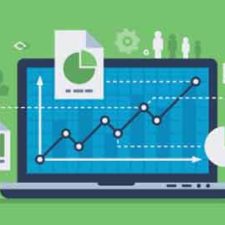The term Data Analysis has a vast and deep meaning in Statistics. It is a term used for the systematic process of using statistical and logical methods for describing and evaluating any data. Data analysis is a technique used to inspect, transform and remodel any data to derive a useful piece of information from it.
Analyzing any data correctly is very important as it affects the conclusion to be drawn in any process and also any decision that needs be made. Data analysis has got many sides and many applications. There are multiple methods for analyzing a piece of data. The process of data analysis is a widely used one in various fields like science, business, politics, social science, etc.
In any business organization, data analysis plays a very important role. It helps in making very crucial decisions easily and quickly. Any business can grow better if its data is analyzed correctly and logically.
The process of data analysis includes various statistical procedures. Any analysis can be a repetitive process where information can be gathered from various sources and analyzed at the same time. In various qualitative researches, every researcher looks out for a particular pattern in the data collected. This helps them to make a better and accurate analysis.
Any technique or principle followed in a particular process of data analysis can be determined by the exact method of application employed. There are various methods of applications namely case study, field study, content analysis, biography, etc. Data, on the other hand, can also be of various types such as field observations, notes, documents, audio contents, and visual contents.
To ensure that the raw information collected is completely genuine, it is important to be very careful while gathering them from various sources. Any data collected should be accurate and completely correct. Inaccurate piece of information leads to incorrect statistical analysis of it and misleads everyone in turn. Therefore accuracy of data should be of utmost importance.
Things that are to be considered where analyzing any data
There are a lot of things that are needed to be kept in mind before carrying out any data analysis. These small and big considerations have a huge impact on the correctness of whole data analysis. The most important thing is that every data researcher must possess all necessary qualities required to analyze any data. This will help him or her to carry out every process better and accurately.
The next step is to choose a correct process of collection of data. This step is very important as it determines its accuracy. Along with that, you should also select the perfect process for analyzing every data. This step is very important as all final results are affected a lot by the process it is determined.
Then you must find out references from the data without being biased at all. This helps in getting perfect results. Next process is to categorize the data into small groups and carry out analysis processes within them.
You must employ an exact formula of statistics. Correct statistical approach makes any process easier. Lack of clarity in data and in its understanding can lead to false outcomes. You must come with an honest analysis of the data that is collected. This is very important. You should make every analysis independently without being biased towards any party.
The way you present your data matters a lot. It is very important to present your collected data and final analysis in the correct way to help others understand better. The conditions of your surroundings also have a great impact on the analyzing of raw information. Correct methods for gathering information and recording them without any error are very important to get accurate results.
All important texts should be separated from the whole content collected. This helps to provide a better quality of data analysis. Your research becomes more precise and holds great quality.
Every employee carrying out the task of data analysis should be trained thoroughly. They are the ones who perform a very important task. Based on their findings a company can make important decisions and draw effective conclusions.
The data that is analyzed should be reliable. Any company has a lot to do with the accuracy of these pieces of information. They should be validated by top professionals present in the industry. Any analysis procedure should be conducted after proper research. It should have good depth as it can prove very helpful.
Detailed discussion on every process involved in data analysis
Data analysis basically means breaking total information into smaller parts which are analyzed separately. It is helpful for converting any raw data into useful pieces of information that can help any concern to draw a necessary conclusion and make important decisions. Data collected are used to answer various questions that are raised within a particular organization and prove important theories.
There are many steps involved in the complete process of data analysis. All of these steps need to be performed repeatedly. The accuracy of all previous steps affects the result of the latter. So you must understand these steps very nicely before you go out to analyze any data and process it to useful information.
Finding out the data required
If data analysis is considered to be a chemical reaction then the data is a raw material. Without raw material, no experiment can be conducted. Similarly, with proper data, any process of analysis cannot commence. The data acts as an input operator in the whole procedure which can be variable in various situations.
Raw data that needs to be collected depends upon the type of analysis to be done. Everyone conducting the analysis or anyone who will need the final result of the analysis determines the type of raw information to be collected. The basic attribute based on which data needs to be collected is termed as an experimental unit. All the various types of information regarding this experimental unit should be decided from beforehand and collected accordingly.
Data collected can be of any type. It can be numeric variables or alphabetical. For example, if the experimental unit is a person, then the variable collected can be his age, address, monthly income, etc. These variable data can be either numbers or texts made up of alphabets.
Collection of the raw information
The raw information that needs to be processed is collected from various sources. The place for the collection is decided by the data analysts. They convey their decision to the employees who are supposed to carry out the data collection procedure. People like IT professionals in the concern are most likely the ones who gather the raw data required in the analysis.
Data collection can also be conducted through various sensory tools in the environment. For example cameras at traffic signals, recording tapes, satellites, video cameras, etc can act as these sensory tools employed in collecting raw data. Interview, online documents or hard copies can also serve as fantastic tools for data collection.
Processing the raw data collected
The data collected should be processed at the very beginning. They should be sorted and arranged in the correct order to make them suitable for analysis. For example, certain types of data may need to be organized in a properly structured table. This involves rewriting them in rows and columns in a spreadsheet or some other statistical application.
To do the above tasks one needs to be proficient in using spreadsheets. This is very important in data analysis. Proper representation of data can be very helpful in all the latter steps of data analysis.
Removing the useless data
After raw data is processed and arranged in a correct manner there may be many useless data that find no place in the whole process. There may be duplicate data of an original one or there can be incorrect data. All this information should be removed from system’s database.
As a professional enter any data in the spreadsheet or any other similar software, every useless piece of information gives an error. Therefore the professional clean them by rectifying those errors in the whole process.
Different kinds of steps involved in data cleaning process are matching the information collected, finding out any incorrect data, maintaining the quality of the whole data, sorting out the duplicate ones and dividing them into proper columns. Certain analytical methods can also be involved to identify useful data and clean them.
Understanding the processed data
The next step that comes after data cleaning is the understanding of clean and processed data. Here data analysts come into action. They apply different techniques to understand all the facets of the raw information collected. In this whole process, the analysts can feel the need for more raw data or some more data cleaning. Therefore all the above processes need to be repeated all over again.
Here the technique descriptive statistics may be involved to understand the data better. The technique of data visualization may also be used to represent the raw data in proper graphs to get a better understanding of all its attributes.
Remodeling the data
Various mathematical formulas and techniques referred to as algorithms can be applied to the information to determine any connection between all the variables involved. In certain cases, several models and algorithms are prepared to examine one variable with respect to others present in the whole data. The models and algorithms need to be accurate to ensure the accuracy of the whole process.
Using data product
A data product is a term used for statistical software where data can be given as input and the software produces output. The software is based on the algorithms used in the process of data analysis. One example of the software can be the one that analyzes the data about the books purchased by a customer and recommends other books that the customer might like to read.
Presentation of the final result of the data analysis
After the data analysts are done with their job of analyzing the data as asked, they will have to present the final result in front of the customers concerned. For this, they may need to use various formats in which the presentation can be done. The customers will give their useful feedbacks after seeing the finished product.
Based on the feedback from the customers the data analysts will understand whether they are satisfied with the result or some more analyzing needs to be carried out. Therefore there can be again the repetition of all the procedures from the beginning all over again. This is why data analysis is always called an iterative process which can carry on and on.
Different kinds of obstacles in the path of accurate analysis
There is more than one analyst performing any data analysis. So they are bound to have some discrepancies. These differences act as obstacles in the path of accurate data analysis.
Not having a clear concept of the data
An accurate analysis needs to have the correct form of data. There can be various misleading data or opinions which can lead to confusions.
Being Biased
The process of data analysis demands the analysts to be completely unbiased throughout. Biases surely lead to misleading analysis.
Using incorrect numerical algorithms
Certain people do not have proper knowledge of numbers and others deliberately use wrong algorithms to disturb the whole process of the data analysis.
Data analysis is a vast subject and a very important job that every concern needs to carry out. Therefore using effective methods to complete the whole process accurately is very important. Accurate data analysis helps any organization to make big decisions that can determine its fate.
Author bio:
The author, Susan Anderson has completed her masters in Statistics from New York University. She is currently involved in a Research and Development Program for the US government. She has been an online statistics tutor for the past 5 years and has helped those complete more than 100 assignments. You can always seek her statistical assistance if you face any difficulty in this subject.



















